Were There Animals In The Garden Of Eden
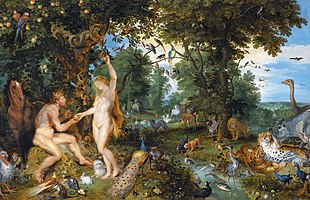
In Abrahamic religions, the Garden of Eden (Hebrew: גַּן־עֵדֶן, gan-ʿĒḏen ) or Garden of God ( גַּן־יְהֹוֶה , gan-YHWH ), also called the Terrestrial Paradise, is the biblical paradise described in Genesis 2-3 and Ezekiel 28 and 31.[1] [two]
The location of Eden is described in the Book of Genesis every bit the source of four tributaries. Various suggestions take been made for its location:[three] at the head of the Farsi Gulf, in southern Mesopotamia (at present Iraq) where the Tigris and Euphrates rivers run into the sea;[4] and in Armenia.[5] [vi] [7]
Like the Genesis flood narrative, the Genesis creation narrative and the business relationship of the Tower of Babel, the story of Eden echoes the Mesopotamian myth of a king, as a primordial man, who is placed in a divine garden to guard the tree of life.[viii] The Hebrew Bible depicts Adam and Eve as walking around the Garden of Eden naked due to their sinlessness.[nine]
Mentions of Eden are as well made in the Bible elsewhere in Genesis,[10] in Isaiah 51:3,[11] Ezekiel 36:35,[12] and Joel 2:iii;[xiii] Zechariah 14 and Ezekiel 47 utilise paradisical imagery without naming Eden.[14]
The name derives from the Akkadian edinnu , from a Sumerian word edin pregnant "plain" or "steppe", closely related to an Aramaic root discussion meaning "fruitful, well-watered".[2] Another estimation associates the name with a Hebrew word for "pleasure"; thus the Vulgate reads "paradisum voluptatis" in Genesis 2:8, and the Douay–Rheims Bible, following, has the wording "And the Lord God had planted a paradise of pleasure".[xv]
Biblical narratives [edit]
Genesis [edit]

Expulsion from Paradise, painting past James Tissot (c. 1896–1902)

The 2nd office of the Genesis cosmos narrative, Genesis 2:iv–3:24, opens with YHWH-Elohim (translated here "the FiftyORD God")[a] creating the offset man (Adam), whom he placed in a garden that he planted "due east in Eden":[16]
And out of the ground made the Lord God to grow every tree that is pleasant to the sight, and good for food; the tree of life as well in the midst of the garden, and the tree of knowledge of good and evil.
— [17]
The human was gratuitous to eat from whatsoever tree in the garden except the tree of life and tree of the knowledge of good and evil, which were taboo. Last of all, God fabricated a woman (Eve) from a rib of the man to exist a companion for the man. In Genesis 3, the human being and the woman were seduced by the serpent into eating the forbidden fruit, and they were expelled from the garden to forestall them from eating of the tree of life, and thus living forever. Cherubim were placed due east of the garden, "and a flaming sword which turned every way, to guard the fashion of the tree of life".[18]
Genesis 2:x-xiv[xix] lists iv rivers in association with the garden of Eden: Pishon, Gihon, Hiddekel (the Tigris), and Phirat (the Euphrates). It also refers to the state of Cush—translated/interpreted as Ethiopia, but thought by some to equate to Cossaea, a Greek name for the land of the Kassites.[20] These lands prevarication north of Elam, immediately to the east of aboriginal Babylon, which, unlike Ethiopia, does lie within the region existence described.[21] In Antiquities of the Jews, the first-century Jewish historian Josephus identifies the Pishon as what "the Greeks called Ganges" and the Geon (Gehon) equally the Nile.[22]
Co-ordinate to Lars-Ivar Ringbom, the paradisus terrestris is located in Takab in northwestern Iran.[23]
Ezekiel [edit]
In Ezekiel 28:12-19[24] the prophet Ezekiel the "son of man" sets downwards God'due south discussion against the king of Tyre: the rex was the "seal of perfection", adorned with precious stones from the day of his creation, placed by God in the garden of Eden on the holy mountain as a guardian cherub. However, the king sinned through wickedness and violence, and so he was driven out of the garden and thrown to the world, where now he is consumed past God'southward burn: "All those who knew you in the nations are appalled at you, yous have come up to a horrible finish and will be no more than." (Ezekiel 28:19).
Co-ordinate to Terje Stordalen, the Eden in Ezekiel appears to be located in Lebanese republic.[25] "[I]t appears that the Lebanon is an alternative placement in Phoenician myth (every bit in Ez 28,13, 3.48) of the Garden of Eden",[26] and there are connections between paradise, the Garden of Eden and the forests of Lebanese republic (perhaps used symbolically) inside prophetic writings.[27] Edward Lipinski and Peter Kyle McCarter accept suggested that the garden of the gods, the oldest Sumerian analog of the Garden of Eden, relates to a mountain sanctuary in the Lebanon and Anti-Lebanon ranges.[28]
Proposed locations [edit]
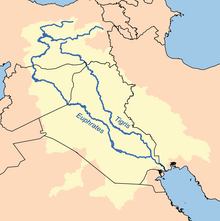
Map showing the rivers in the Middle East known in English as the Tigris and Euphrates
The location of Eden is described in Genesis 2:10–14:[29]
And a river went out of Eden to h2o the garden; and from thence information technology was parted, and became four heads. The name of the showtime is Pishon; that is it which compasseth the whole country of Havilah, where in that location is aureate; and the gold of that land is expert; at that place is bdellium and the onyx stone. And the proper noun of the 2nd river is Gihon; the same is it that compasseth the whole land of Cush. And the name of the tertiary river is Tigris; that is it which goeth toward the eastward of Asshur. And the 4th river is the Euphrates.
Suggestions for the location of the Garden of Eden include[3] [thirty] the head of the Persian Gulf, every bit argued by Juris Zarins, in southern Mesopotamia (at present Republic of iraq and Kuwait) where the Tigris and Euphrates rivers come across the bounding main;[4] and in the Armenian Highlands or Armenian Plateau.[5] [31] [6] [vii] British archaeologist David Rohl locates it in Islamic republic of iran, and in the vicinity of Tabriz, but this suggestion has not defenseless on with scholarly sources.[32]
Some religious groups have believed the location of the garden to be local to them, outside of the Middle East. Some early leaders of Mormonism held that it was located in Jackson County, Missouri.[33] The 20th-century Panacea Guild believed information technology was located at the site of their home town of Bedford, England,[34] while preacher Elvy Due east. Callaway believed it was on the Apalachicola River in Florida, near the town of Bristol.[35] Some suggested that the location is in Jerusalem.[36]
On his tertiary voyage to the Americas in 1498, Christopher Columbus thought he may accept reached the Earthly Paradise upon first seeing the Southward American mainland.[37]
Eridu Hypothesis [edit]
Archeologist Richard James Fischer believes Eridu was the location that inspired the story.[38]
Parallel concepts [edit]
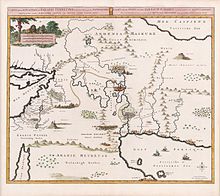
Map by Pierre Mortier, 1700, based on theories of Pierre Daniel Huet, Bishop of Avranches. A caption in French and Dutch reads: Map of the location of the terrestrial paradise, and of the state inhabited by the patriarchs, laid out for the proficient agreement of sacred history, by M. Pierre Daniel Huet
A number of parallel concepts to the biblical Garden of Eden be in various other religions and mythologies. Dilmun in the Sumerian story of Enki and Ninhursag is a paradisaical abode[39] of the immortals, where sickness and death were unknown.[xl] The garden of the Hesperides in Greek mythology was likewise somewhat like to the Jewish concept of the Garden of Eden, and past the 16th century a larger intellectual association was made in the Cranach painting. In this painting, simply the action that takes place in that location identifies the setting as distinct from the Garden of the Hesperides, with its golden fruit.
The give-and-take "paradise" entered English from the French paradis , inherited from the Latin paradisus , from the Greek parádeisos ( παράδεισος ). The Greek, in turn, was derived from an Former Iranian form, itself from the Proto-Iranian *parādaiĵah-, "walled enclosure", which was derived from the Old Persian 𐎱𐎼𐎭𐎹𐎭𐎠𐎶 (p-r-d-y-d-a-g, /paridaidam/ , whence from the Avestan 𐬞𐬀𐬌𐬭𐬌⸱𐬛𐬀𐬉𐬰𐬀 , pairi-daêza- . The literal meaning of this discussion is "walled (enclosure)", from pairi- 'around' (cognate with the Greek περί and the English language peri-, of identical meaning), and -diz, "to make, form (a wall), build" (cognate with the Greek τεῖχος , 'wall'). The word'south etymology is ultimately derived from a PIE root, *dheigʷ , "to stick and fix (a wall)", and *per , "around".
By the 6th/5th century BCE, the Old Iranian discussion had been borrowed into the Akkadian language every bit pardesu , "domain". It subsequently came to signal the expansive walled gardens of the Showtime Western farsi Empire, and was later on borrowed into a number of languages; into Greek equally παράδεισος ( parádeisos ), "park for animals", in Anabasis, the most famous piece of work of the early on 4th century BCE Athenian Xenophon; into Aramaic as pardaysa , "majestic park"; and into Hebrew as {{transl|he|pardes ( פַּרְדֵּס ), "orchard", appearing thrice in the Tanakh: in the Song of Solomon (4:13), Ecclesiastes (2:5) and Nehemiah (ii:viii).
In the Septuagint (3rd–1st centuries BCE), the Greek παράδεισος ( parádeisoswas ) used to translate both the Hebrew פרדס ( pardesand ) and גן ( gan ), meaning "garden" (eastward.chiliad. (Genesis two:8, Ezekiel 28:13): it is from this usage that the employ of "paradise" to refer to the Garden of Eden derives. The same usage also appears in Standard arabic and in the Quran as firdaws فردوس .
The idea of a walled enclosure was non preserved in most Iranian usage, and generally came to refer to a plantation or other cultivated area, not necessarily walled. For case, the Old Iranian word survives as pardis in New Persian, equally well equally its derivative pālīz (or jālīz ), which denotes a vegetable patch.
The discussion pardes occurs 3 times in the Hebrew Bible, but ever in contexts other than a connection with Eden: in the Vocal of Solomon 4:thirteen: "Thy plants are an orchard ( pardes ) of pomegranates, with pleasant fruits; camphire, with spikenard"; Ecclesiastes ii:five: "I made me gardens and orchards ( pardes ), and I planted trees in them of all kind of fruits"; and in Nehemiah ii:8: "And a letter of the alphabet unto Asaph the keeper of the king's orchard ( pardes ), that he may give me timber to brand beams for the gates of the palace which appertained to the house, and for the wall of the city." In these examples, pardes clearly means "orchard" or "park", but in the apocalyptic literature and in the Talmud "paradise" gains its associations with the Garden of Eden and its heavenly prototype, and in the New Testament "paradise" becomes the realm of the blessed (equally opposed to the realm of the cursed) amid those who take already died, with literary Hellenistic influences.
Other views [edit]
Jewish eschatology [edit]
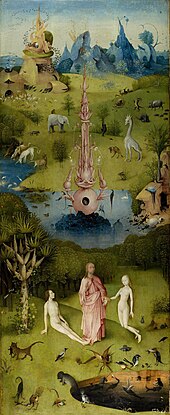
In the Talmud and the Jewish Kabbalah,[41] the scholars agree that there are two types of spiritual places called "Garden in Eden". The kickoff is rather terrestrial, of abundant fertility and luxuriant vegetation, known as the "lower Gan Eden" ( gan meaning garden). The second is envisioned as being celestial, the habitation of righteous, Jewish and not-Jewish, immortal souls, known as the "college Gan Eden". The rabbis differentiate between Gan and Eden. Adam is said to take dwelt only in the Gan , whereas Eden is said never to be witnessed by whatever mortal eye.[41]
According to Jewish eschatology,[42] [43] the higher Gan Eden is chosen the "Garden of Righteousness". It has been created since the commencement of the world, and will appear gloriously at the stop of time. The righteous habitation at that place will savor the sight of the heavenly chayot carrying the throne of God. Each of the righteous will walk with God, who volition lead them in a dance. Its Jewish and non-Jewish inhabitants are "clothed with garments of light and eternal life, and eat of the tree of life" (Enoch 58,3) most to God and his anointed ones.[43] This Jewish rabbinical concept of a college Gan Eden is opposed by the Hebrew terms gehinnom [44] and sheol , figurative names for the identify of spiritual purification for the wicked expressionless in Judaism, a place envisioned every bit beingness at the greatest possible distance from heaven.[45]
In modernistic Jewish eschatology it is believed that history volition complete itself and the ultimate destination will exist when all mankind returns to the Garden of Eden.[46]
[edit]
In the 1909 volume Legends of the Jews, Louis Ginzberg compiled Jewish legends found in rabbinic literature. Amongst the legends are ones about the two Gardens of Eden. Beyond Paradise is the higher Gan Eden, where God is enthroned and explains the Torah to its inhabitants. The higher Gan Eden contains three hundred and ten worlds and is divided into 7 compartments. The compartments are not described, though it is unsaid that each compartment is greater than the previous one and is joined based on one's merit. The first compartment is for Jewish martyrs, the second for those who drowned, the third for "Rabbi Johanan ben Zakkai and his disciples," the fourth for those whom the deject of glory carried off, the fifth for penitents, the sixth for youths who take never sinned; and the seventh for the poor who lived decently and studied the Torah.
In chapter two, Legends of the Jews gives a brief description of the lower Gan Eden. The tree of knowledge is a hedge around the tree of life, which is so vast that "information technology would take a human 5 hundred years to traverse a distance equal to the diameter of the trunk". From beneath the trees catamenia all the globe'south waters in the form of four rivers: Tigris, Nile, Euphrates, and Ganges. Afterward the fall of human being, the world was no longer irrigated by this h2o. While in the garden, though, Adam and Eve were served meat dishes by angels and the animals of the earth understood human language, respected mankind as God'due south image, and feared Adam and Eve. When i dies, one's soul must pass through the lower Gan Eden in order to reach the higher Gan Eden. The way to the garden is the Cavern of Machpelah that Adam guards. The cave leads to the gate of the garden, guarded by a cherub with a flaming sword. If a soul is unworthy of inbound, the sword annihilates it. Within the garden is a pillar of fire and fume that extends to the higher Gan Eden, which the soul must climb in order to reach the higher Gan Eden.
Islamic view [edit]
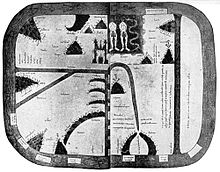
Mozarabic globe map from 1109 with Eden in the East (at top)
The term jannāt ʿadni ("Gardens of Eden" or "Gardens of Perpetual Residence") is used in the Quran for the destination of the righteous. There are several mentions of "the Garden" in the Quran,[48] while the Garden of Eden, without the word ʿadn ,[49] is normally the fourth layer of the Islamic sky and not necessarily thought as the dwelling place of Adam.[50] The Quran refers oft over various Surah about the first dwelling of Adam and Hawwa (Eve), including surat Sorry, which features 18 verses on the subject area (38:71–88), surat al-Baqara, surat al-A'raf, and surat al-Hijr although sometimes without mentioning the location. The narrative mainly surrounds the resulting expulsion of Hawwa and Adam after they were tempted past Iblis (Satan). Despite the biblical account, the Quran mentions only one tree in Eden, the tree of immortality, from which God specifically forbade Adam and Eve. Some exegesis added an business relationship, about Satan, disguised as a ophidian to enter the Garden, repeatedly told Adam to eat from the tree, and eventually both Adam and Eve did then, resulting in disobeying God.[51] These stories are also featured in the hadith collections, including al-Tabari.[52]
Latter Day Saints [edit]
Followers of the Latter Day Saint movement believe that later on Adam and Eve were expelled from the Garden of Eden they resided in a place known as Adam-ondi-Ahman, located in present-day Daviess County, Missouri. It is recorded in the Doctrine and Covenants that Adam blessed his posterity there and that he will return to that place at the time of the final judgement[53] [54] in fulfillment of a prophecy prepare forth in the Bible.[55]
Numerous early leaders of the Church, including Brigham Immature, Heber C. Kimball, and George Q. Cannon, taught that the Garden of Eden itself was located in nearby Jackson County,[33] but there are no surviving start-mitt accounts of that doctrine being taught by Joseph Smith himself. LDS doctrine is unclear as to the exact location of the Garden of Eden, but tradition amid Latter-Mean solar day Saints places it somewhere in the vicinity of Adam-ondi-Ahman, or in Jackson County.[56] [57]
Gnosticism [edit]
The 2nd-century Gnostic teacher Justin held that there were three original divinities, a transcendental being called the Adept, an intermediate male effigy known equally Elohim and Eden who is an Globe-mother. The world is created from the honey of Elohim and Eden, but evil later is brought into the universe when Elohim learns of the existence of the Skillful in a higher place him and ascends trying to attain it.[58]
Art and literature [edit]
Art [edit]
One of oldest depictions of Garden of Eden is fabricated in Byzantine way in Ravenna, while the city was still nether Byzantine control. A preserved bluish mosaic is part of the mausoleum of Galla Placidia. Circular motifs represent flowers of the garden of Eden. The Garden of Eden motifs virtually ofttimes portrayed in illuminated manuscripts and paintings are the "Slumber of Adam" ("Cosmos of Eve"), the "Temptation of Eve" past the Ophidian, the "Fall of Man" where Adam takes the fruit, and the "Expulsion". The idyll of "Naming Solar day in Eden" was less oft depicted. Michelangelo depicted a scene at the Garden of Eden on the Sistine Chapel ceiling.
-
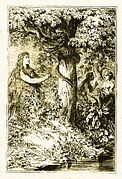
After wandering through the Garden of Eden, Eve takes the forbidden fruit while Lilith speaks to Adam (past Carl Poellath, c. 1886)
Literature [edit]
For many medieval writers, the epitome of the Garden of Eden as well creates a location for man love and sexuality, often associated with the classic and medieval trope of the locus amoenus.[59]
In the Divine One-act, Dante Alighieri places the Garden at the summit of Mt. Purgatory. Dante, the pilgrim, emerges into the Garden of Eden in Canto 28 of Purgatorio. Here he is told that God gave the Garden of Eden to man "in earnest, or as a pledge of eternal life," but man was just able to dwell in that location for a short time because he soon fell from grace. In the poem, the Garden of Eden is both human and divine: while information technology is located on world at the elevation of Mt. Purgatory, it besides serves as the gateway to the heavens.[60]
Much of Milton'south Paradise Lost occurs in the Garden of Eden.
The showtime act of Arthur Miller's 1972 play Cosmos of the World and Other Business is fix in the Garden of Eden.
See too [edit]
- Antelapsarianism
- Christian naturism
- Ballsy of Gilgamesh
- Eridu
- Fertile Crescent
- Golden Age
- Heaven in Judaism
- Hesperides
- Jannah
- Nondualism
- Persian gardens
- Purgatorio
- Sacred garden
- The Summerland
- Tamoanchan
- Utopia
Notes [edit]
- ^ Meet Names of God in Judaism
References [edit]
- ^ Metzger, Bruce Manning; Coogan, Michael D (2004). The Oxford Guide To People And Places Of The Bible. Oxford University Press. p. 62. ISBN978-0-19-517610-0 . Retrieved 22 Dec 2012.
- ^ a b Cohen 2011, pp. 228–229
- ^ a b Wilensky-Lanford, Brook (2012). Paradise Lust: Searching for the Garden of Eden . Grove Press. ISBN9780802145840.
paradise animalism.
- ^ a b Hamblin, Dora Jane (May 1987). "Has the Garden of Eden been located at last? (Dead Link)" (PDF). Smithsonian. xviii (2). Archived from the original (PDF) on 9 January 2014. Retrieved 8 January 2014.
- ^ a b Zevit, Ziony. What Really Happened in the Garden of Eden? 2013. Yale University Press, p. 111. ISBN 9780300178692
- ^ a b Duncan, Joseph E. Milton's Earthly Paradise: A Historical Written report of Eden. 1972. University Of Minnesota Printing, pp. 96, 212. ISBN 9780816606337
- ^ a b Scafi, Alessandro. Return to the Sources: Paradise in Armenia, in: Mapping Paradise: A History of Heaven on Globe. 2006. London-Chicago: British Library-Academy of Chicago Printing, pp. 317–322. ISBN 9780226735597
- ^ Davidson 1973, p. 33.
- ^ Donald Miller (2007) Miller 3-in-one: Bluish Like Jazz, Through Painted Deserts, Searching for God, Thomas Nelson Inc, ISBN 978-1418551179, p. PT207
- ^ Genesis 13:10
- ^ Isaiah 51:three
- ^ Ezekiel 36:35
- ^ Joel 2:iii
- ^ Tigchelaar 1999, p. 37
- ^ "Latin Vulgate Bible with Douay–Rheims and King James Version Side-past-Side+Complete Sayings of Jesus Christ". www.latinvulgate.com. Archived from the original on 2021-03-12. Retrieved 2021-03-x .
- ^ Levenson 2004, p. 13 "The root of Eden denotes fertility. Where the wondrously fertile gard was thought to have been located (if a realistic location was ever conceived) is unclear. The Tigris and Euphrates are the two smashing rivers of the Mesopotamia (now establish in modernistic Iraq). But the Piston is unidentified, and the only Gihon in the Bible is a spring in Jerusalem (i Kings ane.33, 38)."
- ^ Genesis two:9
- ^ Genesis 3:24
- ^ Genesis 2:10–14
- ^ "The Jewish Quarterly Review". The Jewish Quarterly Review. Academy of Pennsylvania Printing. 64–65: 132. 1973. ISSN 1553-0604. Retrieved 2014-02-xix .
...equally Cossaea, the country of the Kassites in Mesopotamia [...]
- ^ Speiser 1994, p. 38
- ^ Josephus, Antiquities of the Jews. Book I, Chapter i, Section iii.
- ^ Lars-Ivar Ringbom, Paradisus Terrestris. Myt, Bild Och Verklighet, Helsingfors, 1958.
- ^ Ezekiel 28:12–19
- ^ Stordalen 2000, p. 164
- ^ Chocolate-brown 2001, p. 138
- ^ Swarup 2006, p. 185
- ^ Smith 2009, p. 61
- ^ Genesis 2:10–14
- ^ Carol A. Colina, The Garden of Eden: A Modern Mural' Perspectives on Science and Christian Religion 52 [March 2000]: 31-46 https://world wide web.asa3.org/ASA/PSCF/2000/PSCF3-00Hill.html
- ^ Day, John. Yahweh and the Gods and Goddesses of Canaan. 2002. Sheffield Academic Press, p. xxx. ISBN 9780826468307
- ^ Cline, Eric H. (2007). From Eden to Exile: Unraveling Mysteries of the Bible. National Geographic. p. 10. ISBN978-1-4262-0084-7.
- ^ a b "Joseph Smith/Garden of Eden in Missouri", FairMormon Answers
- ^ Shaw, Jane (2012). Octavia, Daughter of God. Random House. p. 119. ISBN9781446484272.
- ^ Gloria Jahoda, The Other Florida, chap. iv, "The Garden of Eden." ISBN 9780912451046
- ^ "Jerusalem as Eden". 24 August 2015.
- ^ Bergreen, Lawrence (2011). Columbus: The Four Voyages, 1493–1504. Penguin Group US. p. 236. ISBN978-1101544327.
- ^ Fischer, Richard (2008). Historical Genesis: From Adam to Abraham. University Press of America. p. 227. ISBN9780761838067 . Retrieved 2 Apr 2022.
- ^ Mathews 1996, p. 96.
- ^ Cohen 2011, p. 229.
- ^ a b Gan Eden – JewishEncyclopedia; 02-22-2010.
- ^ Olam Ha-Ba – The Afterlife - JewFAQ.org; 02-22-2010.
- ^ a b Eshatology – JewishEncyclopedia; 02-22-2010.
- ^ "Gehinnom is the Hebrew name; Gehenna is Yiddish." Gehinnom – Judaism 101 websourced 02-10-2010.
- ^ "Gan Eden and Gehinnom". Jewfaq.org. Retrieved 2011-06-30 .
- ^ "End of Days". Aish. 11 January 2000. Retrieved i May 2012.
- ^ Qur'an, two:35, 7:19, 20:117, 61:12
- ^ Come across list of occurrences.
- ^ Patrick Hughes, Thomas Patrick Hughes Dictionary of Islam Asian Educational Services 1995 ISBN 978-8-120-60672-2 p. 133
- ^ Leaman, Oliver The Quran, an encyclopedia, p. xi, 2006
- ^ Wheeler, Brannon Mecca and Eden: ritual, relics, and territory in Islam p. 16, 2006
- ^ "Doctrine and Covenants 107:53".
- ^ "Doctrine and Covenants 116:1".
- ^ "Daniel 7:13–14, 22".
- ^ Bruce A. Van Orden, "I Have a Question: What do we know nearly the location of the Garden of Eden?", Ensign, Jan 1994, pp. 54–55.
- ^ "What is Mormonism? Overview of Mormon Beliefs – Mormonism 101". www.mormonnewsroom.org. 2014-10-thirteen. Archived from the original on 2012-03-10. Retrieved 2018-ten-31 .
- ^ "Gnosticism - Apocryphon of John". Encyclopædia Britannica. Retrieved 2022-01-28 .
- ^ Curtius 1953, p. 200, n.31
- ^ "Dante Lab at Dartmouth Higher: Reader". dantelab.dartmouth.edu . Retrieved 2021-11-06 .
Bibliography [edit]
- Brown, John Pairman (2001). Israel and Hellas, Volume three. Walter de Gruyter. ISBN9783110168822.
- Cohen, Chaim (2011). "Eden". In Berlin, Adele; Grossman, Maxine (eds.). The Oxford Dictionary of the Jewish Religion. Oxford University Printing. ISBN9780199730049.
- Curtius, Ernst Robert (1953). European Literature and the Latin Heart Ages . Princeton Upward. ISBN978-0-691-01899-7. Translated by Willard R. Trask.
- Davidson, Robert (1973). Genesis one-11 (commentary past Davidson, R. 1987 [Reprint] ed.). Cambridge, Eng.: Cambridge University Printing. ISBN9780521097604.
- Levenson, Jon D. (2004). "Genesis: Introduction and Annotations". In Berlin, Adele; Brettler, Marc Zvi (eds.). The Jewish Study Bible . Oxford University Press. ISBN9780195297515.
- Mathews, Kenneth A. (1996). Genesis. Nashville, Tenn.: Broadman & Holman Publishers. ISBN9780805401011.
- Smith, Mark S. (2009). "Introduction". In Pitard, Wayne T. (ed.). The Ugaritic Baal Cycle, volume Two. BRILL. ISBN978-9004153486.
- Speiser, E.A. (1994). "The Rivers of Paradise". In Tsumura, D.T.; Hess, R.S. (eds.). I Studied Inscriptions from Before the Inundation. Eisenbrauns. ISBN9780931464881.
- Stordalen, Terje (2000). Echoes of Eden. Peeters. ISBN9789042908543.
- Swarup, Paul (2006). The self-understanding of the Dead Body of water Scrolls Community. Continuum. ISBN9780567043849.
- Tigchelaar, Eibert J. C. (1999). "Eden and Paradise: The Garden Motif in some Early Jewish Texts (ane Enoch and Other Texts Establish at Qumran)". In Luttikhuizen, Gerard P (ed.). Paradise Interpreted. Themes in Biblical narrative. Leiden: Konninklijke Brill. ISBNxc-04-11331-two.
- Willcocks, Sir William, Hormuzd Rassam. Mesopotamian Trade. Noah'southward Flood: The Garden of Eden, in: The Geographical Journal 35, No. four (April 1910). DOI: ten.2307/1777041
External links [edit]
- Smithsonian article on the geography of the Tigris-Euphrates region
- Many translations of II Kings 19:12
- . The American Cyclopædia. 1879.
Source: https://en.wikipedia.org/wiki/Garden_of_Eden
Posted by: duncanfachaps00.blogspot.com

0 Response to "Were There Animals In The Garden Of Eden"
Post a Comment